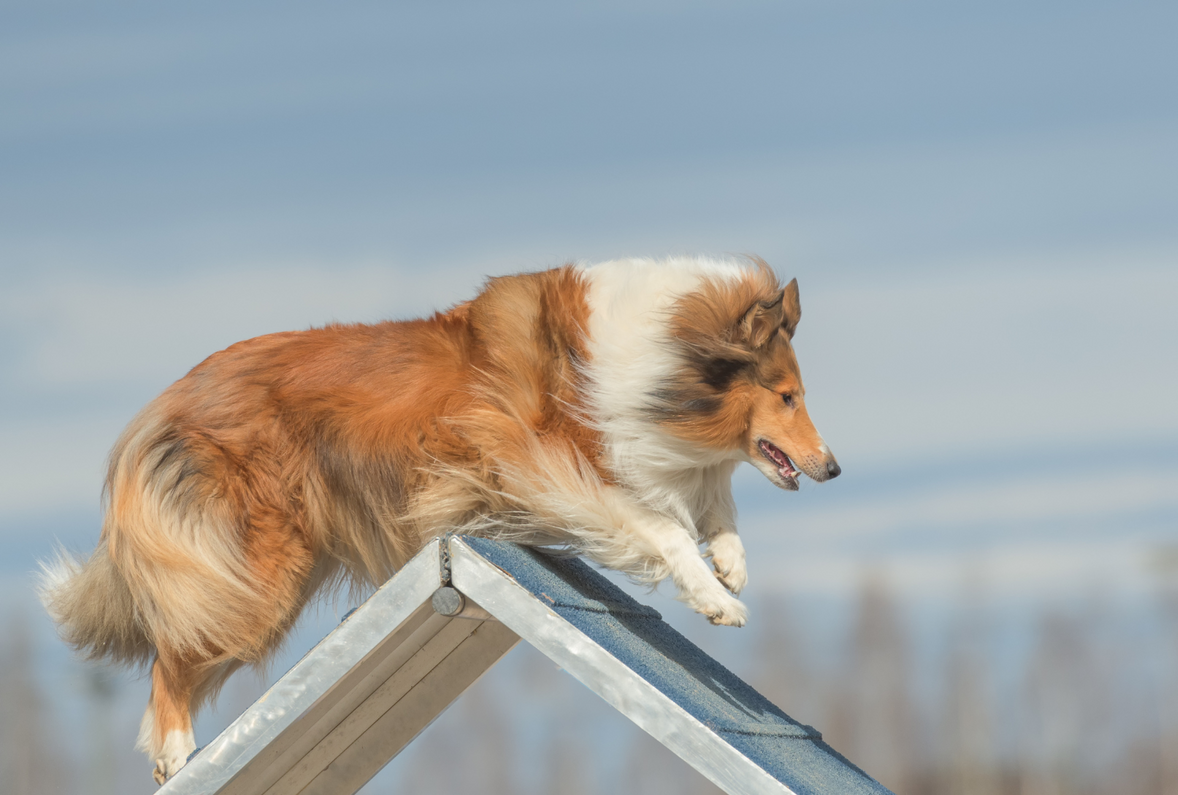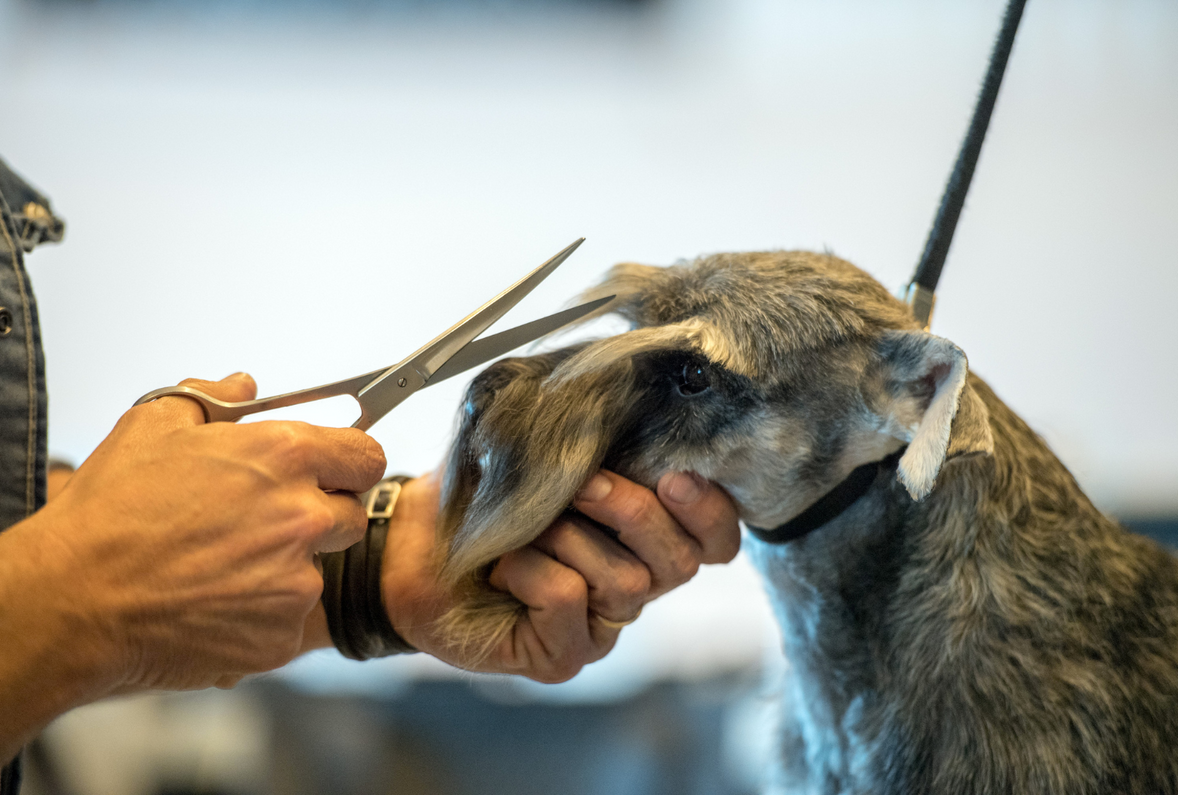Do Summer Thunderstorms Send Your Dog Into a Panic?
The spring and summer months bring thunderstorms, and if you have a storm-phobic dog, I'm sure you're not looking forward to them.
Depending on your pet's experience with storms, as well as the force of any given storm, your dog might simply find a place to hide.
Or he might have a more dramatic reaction (for example, running away or trying to chew his way out of his crate or through a door).
Some reactions are more unsettling than others, but regardless of your dog's response to a storm, it's difficult to know your pet is feeling terrified and you don't know what to do to calm him.
Dogs with Storm Phobia Often Have Other Related Conditions
In a Cornell University retrospective study of over 1,644 dogs presenting with behavior problems over a ten-year period, 2.3 percent were seen for storm phobia.
Research conducted at the University of Pennsylvania and published in the Journal of the American Veterinary Medical Association looked at a possible link between storm phobias, noise phobias and separation anxiety in dogs.
The study revealed there is a high probability (0.88) dogs with noise phobia also have separation anxiety.
The vast majority of dogs with thunderstorm phobia also had separation anxiety. In dogs with separation anxiety, there was a 0.63 probability they also had noise phobia, and a 0.52 likelihood they suffered from storm phobia.
Dogs with thunderstorm phobia had a 0.90 chance of having noise phobia, but dogs with noise phobia had only a 0.76 probability of having storm phobia. Another interesting conclusion was the response to noise is different than the response to thunderstorms, likely due to the unpredictability of thunderstorms, according to study authors.
The researchers recommended that dogs with any of the three conditions should be checked for the other two, and that the interaction among the conditions is important for accurate diagnosis and treatment.
Storm Phobia Symptoms
Storm-phobic dogs will typically display one or more of the following symptoms, which can be mild to extreme:
- Pacing
- Panting
- Drooling
- Trembling
- Staying close to their human
- Vocalization (whining, howling)
- Destructive behavior
- Potty accidents in the house
- Self-harm
Since dogs with one type of phobia tend to have others, it can be difficult for your veterinarian to immediately determine if the phobia is only in relation to thunderstorms.
The first thing your vet might ask is whether your dog also reacts to other loud noises and/or to being left home by himself.
Typically, dogs with a combination of phobias experience more extreme symptoms than dogs with just one condition. Also, the intensity of the phobia tends to impact the dog's response to treatment.
Storm Phobia is Distinct from Other Phobias
While there are often co-existing phobias in one dog, storm phobias actually differ quite a bit from other conditions.
If your dog has separation anxiety, she'll be triggered by activities
leading up your departure, and the departure itself. A dog with noise
phobia will be triggered by the sound of the specific noise(s) she's
bothered by.
Storm-phobic dogs can react to any number of storm-related triggers, including:
- The boom of thunder or the crack of lightening
- The sound of wind or pouring rain
- Darkening skies
- Changes in barometric pressure
- Smells that precede or accompany a storm
Your storm phobic dog will know bad weather is coming long before you do.
Another peculiarity of thunderstorm phobia is it often escalates.
Dogs that have been mild to moderately upset by storms can suddenly
experience a significant increase in anxiety.
This jump in anxiety level can often be linked to a particularly severe storm and perhaps a static electric shock
the dog is exposed to during the storm. Many storm-phobic dogs seem
driven to find areas where electrical grounds can protect them from
static charges – places like sinks, bathtubs, shower enclosures, under
toilet tanks, or next to metal radiators or pipes.
It's a fact that static electricity fields build up during storms and some animals become statically charged.
Treating Dogs with Thunderstorm Phobia
Every storm-phobic dog's response is different, so therapy should be customized to the individual animal and the intensity of his or her response.
- Make a "safe room." This is a place your dog can escape to when a storm is approaching, and it should be available to her at all times – especially when you're not home. The idea is to limit her exposure to as many aspects of thunderstorms as possible. The room would ideally have no windows, or covered windows so the storm can't be seen. If necessary, sound-proofing wallboard can muffle the noise of a storm. Put a solid-sided crate in the room with the door left open, along with a bit of food, water, treats and toys.
-
As part of your dog's therapy, get her used to the room before she
needs it by associating it with fun activities, food treats and gentle,
soothing massage. Some owners use a head collar to calm the dog and more
easily put her into a relaxed down position.
-
As the storm approaches, turn on the lights in the safe room so
lightening flashes won't be extremely obvious, and turn on calming music.
- Pheromone diffusers. Species-specific pheromones are chemical substances that can positively affect an animal's emotional state and behavior. Dog-appeasing pheromone (DAP) is a synthetic form of a pheromone secreted by the mammary glands of nursing dogs. Studies have shown DAP diffusers i are effective therapy for dogs with firework phobias and separation anxiety.
- Behavior modification. One type of behavior modification for storm phobias is to engage your dog in a behavior that earns a reward. Ask your dog to perform a command he's familiar with and reward him if he does. This technique distracts both of you – the dog from his fear of the storm, and you from the temptation to inadvertently reinforce your pet's phobic behavior by petting and soothing him while he's showing anxiety.
-
Another type of behavior modification involves trying to get your dog
busy with a more pleasant activity than storm watching. Play a game
with him or give him a
recreational bone
to gnaw on. Be aware that if your pet's response to storms is intense,
you may not be able to engage him in another activity early in his
treatment program.
- Desensitization. This therapy involves using a CD with reproduced storm sounds to attempt to desensitize your pet. It's best to do this during times of the year when actual storms are few and far between.
-
Unfortunately, desensitization isn't always as effective with storm
phobias as it is with other types of anxiety disorders. That's because
it's difficult to mimic all the various triggers that set off a fear
response in a storm-phobic pet – in particular changes in barometric
pressure, static electricity, and whatever scents dogs notice with an
impending change in the weather. In addition, desensitization has to be
done in each room of the house, because a new coping skill your dog
learns in the living room will be forgotten in the kitchen. These
problems make desensitization more of a challenge in treating storm
phobias.
- Storm jackets. There are a number of different brands of storm jackets to choose from these days, and they have proved very helpful for some dogs with thunderstorm phobias. Storm jackets are designed to be snug-fitting to mimic the sensation of being swaddled, a feeling that is comforting to dogs. You might also consider a calming cap.
- TTouch and Emotional Freedom Technique (EFT). TTouchii is a specific massage technique that can be helpful for anxious pets. EFTiii is a tapping technique that can be used to deal with a wide variety of emotional and physical problems.
- Natural supplements and remedies. Talk to your holistic vet about homeopathic, TCM and other natural remedies that may help relieve your dog's stress. These should be used in conjunction with behavior modification. A few I like are the nutraceuticals l-tryptophan, valerian, GABA, homeopathic Aconitum and the TCM formulas that Calm the Shen.
A U.K. study evaluated a treatment program that used two self-help,
CD-based desensitization and counter-conditioning programs, plus DAP
diffusers, plus a "safe haven" for dogs with fireworks phobia. The
severity of the dogs' phobias was significantly improved, as was their
generalized fear.
If nothing you attempt seems to help your storm-phobic dog, don't
despair. Talk to your vet about a temporary course of drug therapy
(usually with anti-anxiety meds or anti-depressants) in conjunction with
behavior modification and some of the other recommendations outlined
above.
You can also consult an animal behaviorist in your area through the American College of Veterinary Behaviorists. Alternatively, you can look for a Certified Applied Animal Behaviorist at the Animal Behavior Society.
By combining a few different therapies (and trying several to see
which have the most impact), you increase the likelihood of bringing
your dog's phobia under control.
References:
Dr. Becker is the resident proactive and integrative wellness veterinarian of HealthyPets.Mercola.com. You can learn holistic ways of preventing illness in your pets by subscribing to HealthyPets.Mercola.com, an online resource for animal lovers. For more pet care tips, subscribe for FREE to Mercola Healthy Pet Newsletter.
Recent Posts
-
Spring Into Action: Fun Exercise Ideas for Your Canine Companion
Spring Into Action: Fun Exercise Ideas for Your Canine Companion As the winter chill melts away …Mar 26th 2024 -
Understanding Dog Grooming Shears: Cutting Through the Noise
Understanding Dog Grooming Shears: Cutting Through the NoiseDog grooming, or in particular trimming, …Feb 5th 2024 -
Choosing the Perfect Bed for Your Dog: A Guide to all Types of Dog Beds
Types of Dog Beds: Choosing the Perfect Bed for Your DogEvery dog owner knows that a comfortable pla …Jan 26th 2024




